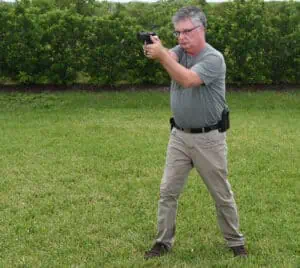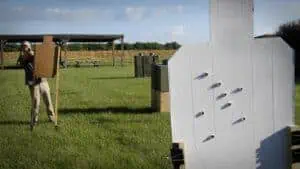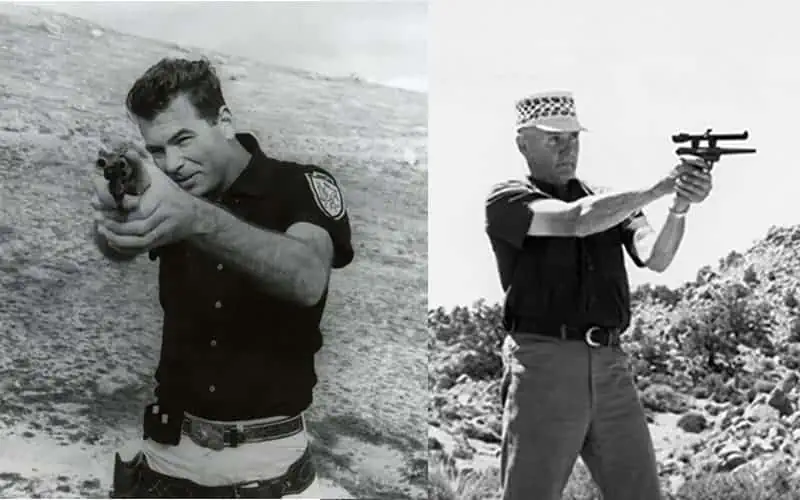A Quick History Of Modern Pistol Stances
Getting into a good, solid shooting stance is part of the curriculum of any basic pistol class. Hours upon hours of debate has sprung up on the internet on the relative merits of the Weaver Stance versus the Modern Isosceles versus a host of other stances. The truth is, which shooting stance you use might just be the most overrated parts about learning how to properly shoot a pistol.

Before you complain, I have seen photos of the Weaver with the strong side foot forward, and photos with it to the rear. This one is to the rear.
First, a quick word about what a good shooting stance really does. First, a proper stance should help you align your pistol with the target as quickly and efficiently as possible. Second, a good stance helps absorb the recoil of your gun. Third, your stance should help you get the sights of your pistol back on-target as fast as you can. Lastly, a good combat pistol stance allows you to quickly shift and change your position as the situation changes around you.
This is where I could talk about how the modern pistol stance as we know it evolved over the years, but rather than do that, I will direct you to Karl Rehn’s exhaustive research on this topic. Instead, I’m going to pick up the narrative in the mid-1950’s, in the small resort town of Big Bear Lake, California, where Colonel Jeff Cooper was running his Leatherslap pistol competitions.
Using Sport As A Proving Ground
The format of the Leatherslap competition was simplicity itself. Two people competed against each other to see who could hit the target faster. Target type and distance varied from year to year, but the idea behind the competition was always to keep it close to what a defensive gun encounter might look like.
For the first years of the competition, people used the then-popular “hip shooting” technique. In this technique, rather than bring your pistol in line with your eyes, your gun is pointed at the target the instant it clears the holster. The people who tried that technique got their shots off quickly. They also missed the target. That’s where an L.A. County Deputy Sheriff named Jack Weaver enters our story.
Just What Is The Weaver Stance, Anyways?
Weaver reasoned that the purpose of drawing your pistol was to hit the target. He also figured that the best way to hit the target was to align the pistol with your eyes. He also reasoned that if holding your gun with one hand was good, holding it with two hands might be even better. Seems logical now, I know, but this was ground-breaking stuff at the time. Weaver won the Leatherslap in 1959 using his technique, which Colonel Cooper quickly adopted and christened the Weaver Stance.
This is where things get interesting. Take a look at the picture below. The first photo is of Jack Weaver himself showing how he holds his pistol. The second is Colonel Cooper, showing what he called the Weaver stance. There is a marked difference between the two. Weaver’s stance appears to be more balanced, more open to the target. His hands are almost parallel, with one elbow bent just slightly more than the other.
Colonel Cooper’s version of the Weaver Stance is quite different. He is bladed off to the target. The elbow of the support hand is bent significantly more than the strong hand. The idea behind this change in grip and stance is that it allows for an isometric push-pull grip on your pistol. Does it work? I think it does. Does it come naturally to new shooters? Well, that’s another story.
Recoil Pushes Against You. Push Back.
Pause for a moment and imagine you’re pushing against a heavy object. How are your feet positioned? Are they in-line with each other, or is one slightly further back than the other? Is your back straight, or bent forward slightly? Where are your hips? Are they a bit in front of your feet, so you’re leaning into whatever force is moving against you?
Now pick up everything I just said, and apply it to managing the recoil of a gun. When we shoot a gun, the recoil of the gun firing goes into our arms, then down through our body. The Weaver Stance, or any other stance for that matter, should allow you to easily manage that recoil and keep your sights on-target.
Enter The Modern Isosceles
Let’s talk about those other stances for a bit, specifically the Modern Isosceles. Just like the Weaver Stance, the Isosceles stance came out of competition. Created by Brian Enos (with some help from Rob Leatham), the Modern Isosceles is the dominant stance in today’s world of firearms training. In practice, it looks a lot like how you would look if you were pushing a car. Your feet are about a shoulder width apart. One foot is slightly back from the other. Your hips are out in front of your feet. The upper body is leaning forward, getting ready to soak up the recoil of your gun. Your head is level, and your arms are out in front of you, slightly bent. If you’ve had any martial arts training or done any boxing, you’ll recognize this position as one of the classic fighting stances that is common to almost all hand to hand combat training.
Range Skill Vs. Real Life
Earlier, I said that stance is overrated. Let me explain why. A bad stance is one of the easiest things to spot when you’re on a square range. It is blatantly obvious to everyone around you if you’re leaning back or your feet are tight together as you shoot. As a result, we can easily diagnose the issues with your stance and correct them so they are more in-line with what our idea of a good shooting stance should be.

A picture-perfect stance goes out the window once real-world concerns like cover and concealment come into play.
However, the fact of the matter is, how you are aiming the pistol and how you manipulate the trigger has a much larger effect on your accuracy. This is why stance is overrated. Is it important? Yes. However, because a bad stance is so easy to spot, it gets corrected quite often in training classes, even though the student should probably learn to press the trigger more smoothly or get a better grip on their gun.
Stance is also overrated because it is a fleeting, temporary thing. The internet is filled with videos of private citizens and law enforcement officers who get involved in gunfights, and pretty much all of those videos have one thing in common. They all show people who immediately look for cover or move to get out of the line of fire once the lead starts to fly. When we talk about stances, we usually talk about them in terms of static firing positions. However, the reality is, moving to cover, or shooting from off-balance or unusual positions happens quite often in the real world. This makes picture-perfect placement of your feet pale in comparison to getting your sights and trigger to work well when they are needed the most.
Aim First. Stance Second.
Learning shooting stances like the Weaver Stance and the Modern Isosceles is important. However, a shooting stance is not a dance step. There are no points awarded in a gunfight for fancy footwork. A shooting stance is a means to an end, and that end is coming out alive on the worst day of your life.





Jack Weaver and Jeff Cooper's stances are fantastic. But I use only right-sided stances with handguns while I am right-handed. I've published Weaver and Cooper stances with a little modification on my blogs. Take a look, please. There are also a lot of stances with the right foot forward (many of them are good for shooting only if they have no strong recoil):
https://www.pinterest.com/pin/386676318005589771/
https://www.pinterest.com/pin/386676318024116041/